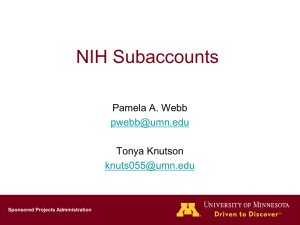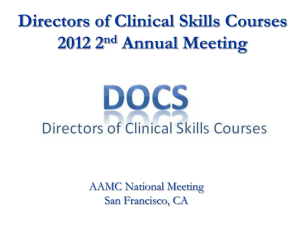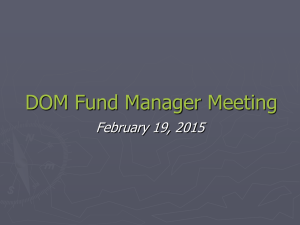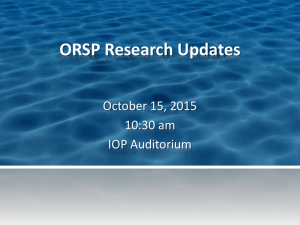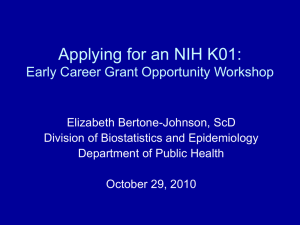see slides from dr. schafer`s presentation
advertisement
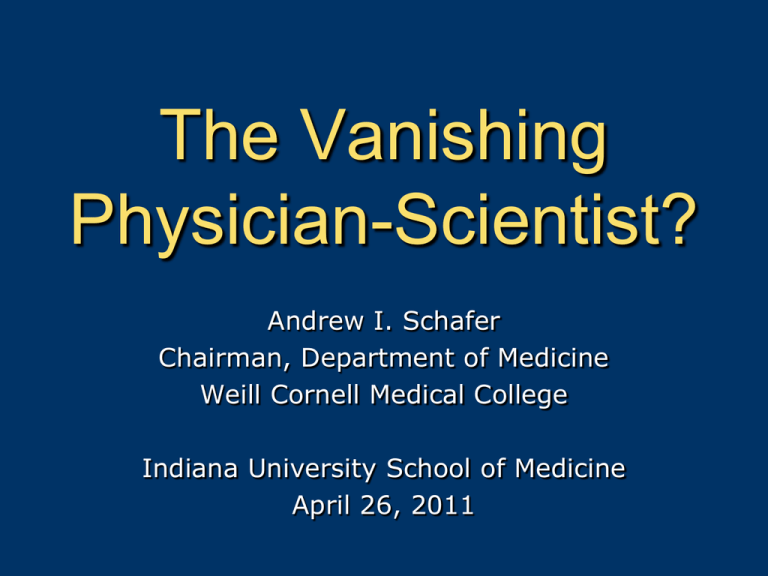
The Vanishing Physician-Scientist? Andrew I. Schafer Chairman, Department of Medicine Weill Cornell Medical College Indiana University School of Medicine April 26, 2011 Physician-Scientists Conduct medical research along entire continuum Devote majority of effort to research Vital and unique role in medical research enterprise Original “endangered species” article: Evolving Role of Physicians in Medical Research The 19th Century and Earlier • Physicians make most major contributions to medical knowledge Evolving Role of Physicians in Medical Research The 19th Century and Earlier • Physicians make most major contributions to medical knowledge Andreas Vesalius(1514-1564) Founder of Modern Human Anatomy Foundation of medicine as “observational science” Evolving Role of Physicians in Medical Research The 19th Century and Earlier • Physicians make most major contributions to medical knowledge William Harvey (1578-1657) Foundation of medicine as “functional science” Evolving Role of Physicians in Medical Research The 19th Century and Earlier • Physicians make most major contributions to medical knowledge Claude Bernard (1813-1878) Founder of modern experimental medicine Evolving Role of Physicians in Medical Research The 19th Century and Earlier • Physicians make most major contributions to medical knowledge Rudolph Virchow (1821-1902) Cellular basis of disease Evolving Role of Physicians in Medical Research The 19th Century and Earlier • Physicians make most major contributions to medical knowledge Robert Koch (1843-1910) Germ theory of disease Evolving Role of Physicians in Medical Research The 19th Century and Earlier • Physicians make most major contributions to medical knowledge Louis Pasteur (1822-1895) (Chemist) Germ theory of disease Evolving Role of Physicians in Medical Research 1890s - 1930s • • • • Dramatic rise of science and research in medicine Science becomes integral to medical education Inspired by clinical observations “bedside to bench” Research labs located in hospitals Evolving Role of Physicians in Medical Research 1930s - WWII • • • • • Dramatic therapeutic advances heighten glamour of medical research Rising public opinion of medical research Philanthropy Physicians (and increasing number of PhDs) doing basic research that is becoming more detached from clinical relevance Interrupted by WWII, when researchers support war effort by returning to applied work Evolving Role of Physicians in Medical Research WWII – 1970s • • “Golden Age” Vannevar Bush: primacy of fundamental research Vannevar Bush SCIENCE: THE ENDLESS FRONTIER Vannevar Bush A Report to the President by the Director of the Office of Scientific Research and Development United States Government Printing Office, 1945 Evolving Role of Physicians in Medical Research WWII – 1970s • • • “Golden Age” Vannevar Bush: primacy of fundamental research Burgeoning of NIH: strong basic sciences orientation Dedication of the New NIH Campus in Bethesda 1940, FDR Evolving Role of Physicians in Medical Research WWII – 1970s • • • • • “Golden Age” Vannevar Bush: primacy of fundamental research Burgeoning of NIH: strong basic sciences orientation PhDs flood medical research arena Age of “triple threat” MD Evolving Role of Physicians in Medical Research 1970s • • • Basic and applied research becoming polarized Mounting pressure from Congress and public advocacy groups for practical payoff in conquest of disease “Bench to bedside” Evolving Role of Physicians in Medical Research 1980s - • • Rising concern about future of physician-scientist IOM, NIH, AAMC reports on “clinical” research Percentage Increase in First Time R01 Applicants (1998-2003) 120% 100% 80% 60% 43% 40% 20% 0% PhD -20% Percentage Increase in First Time R01 Applicants (1998-2003) 120% 104% 100% 80% 60% 43% 40% 20% 0% PhD -20% MD-PhD Percentage Increase in First Time R01 Applicants (1998-2003) 120% 104% 100% 80% 60% 43% 40% 20% -4% 0% PhD -20% MD-PhD MD 1980 7% 6% Percent of PIs / Faculty 5% 4% NIH RPG PIs Med School Faculty (AAMC) 3% 2% 1% 0% 25 30 35 40 45 50 55 60 Age Sources: IMPAC II Current and History Files and AAMC Faculty Roster September 2007, Age Distribution of NIH RPG Investigators and Medical School Faculty 65 70 75 80 85 90 1981 7% 6% Percent of PIs / Faculty 5% 4% NIH RPG PIs Med School Faculty (AAMC) 3% 2% 1% 0% 25 30 35 40 45 50 55 60 Age Sources: IMPAC II Current and History Files and AAMC Faculty Roster September 2007, Age Distribution of NIH RPG Investigators and Medical School Faculty 65 70 75 80 85 90 1982 7% 6% Percent of PIs / Faculty 5% 4% NIH RPG PIs Med School Faculty (AAMC) 3% 2% 1% 0% 25 30 35 40 45 50 55 60 Age Sources: IMPAC II Current and History Files and AAMC Faculty Roster September 2007, Age Distribution of NIH RPG Investigators and Medical School Faculty 65 70 75 80 85 90 1983 7% 6% Percent of PIs / Faculty 5% 4% NIH RPG PIs Med School Faculty (AAMC) 3% 2% 1% 0% 25 30 35 40 45 50 55 60 Age Sources: IMPAC II Current and History Files and AAMC Faculty Roster September 2007, Age Distribution of NIH RPG Investigators and Medical School Faculty 65 70 75 80 85 90 1984 7% 6% Percent of PIs / Faculty 5% 4% NIH RPG PIs Med School Faculty (AAMC) 3% 2% 1% 0% 25 30 35 40 45 50 55 60 Age Sources: IMPAC II Current and History Files and AAMC Faculty Roster September 2007, Age Distribution of NIH RPG Investigators and Medical School Faculty 65 70 75 80 85 90 1985 7% 6% Percent of PIs / Faculty 5% 4% NIH RPG PIs Med School Faculty (AAMC) 3% 2% 1% 0% 25 30 35 40 45 50 55 60 Age Sources: IMPAC II Current and History Files and AAMC Faculty Roster September 2007, Age Distribution of NIH RPG Investigators and Medical School Faculty 65 70 75 80 85 90 1986 7% 6% Percent of PIs / Faculty 5% 4% NIH RPG PIs Med School Faculty (AAMC) 3% 2% 1% 0% 25 30 35 40 45 50 55 60 Age Sources: IMPAC II Current and History Files and AAMC Faculty Roster September 2007, Age Distribution of NIH RPG Investigators and Medical School Faculty 65 70 75 80 85 90 1987 7% 6% Percent of PIs / Faculty 5% 4% NIH RPG PIs Med School Faculty (AAMC) 3% 2% 1% 0% 25 30 35 40 45 50 55 60 Age Sources: IMPAC II Current and History Files and AAMC Faculty Roster September 2007, Age Distribution of NIH RPG Investigators and Medical School Faculty 65 70 75 80 85 90 1988 7% 6% Percent of PIs / Faculty 5% 4% NIH RPG PIs Med School Faculty (AAMC) 3% 2% 1% 0% 25 30 35 40 45 50 55 60 Age Sources: IMPAC II Current and History Files and AAMC Faculty Roster September 2007, Age Distribution of NIH RPG Investigators and Medical School Faculty 65 70 75 80 85 90 1989 7% 6% Percent of PIs / Faculty 5% 4% NIH RPG PIs Med School Faculty (AAMC) 3% 2% 1% 0% 25 30 35 40 45 50 55 60 Age Sources: IMPAC II Current and History Files and AAMC Faculty Roster September 2007, Age Distribution of NIH RPG Investigators and Medical School Faculty 65 70 75 80 85 90 1990 7% 6% Percent of PIs / Faculty 5% 4% NIH RPG PIs Med School Faculty (AAMC) 3% 2% 1% 0% 25 30 35 40 45 50 55 60 Age Sources: IMPAC II Current and History Files and AAMC Faculty Roster September 2007, Age Distribution of NIH RPG Investigators and Medical School Faculty 65 70 75 80 85 90 1991 7% 6% Percent of PIs / Faculty 5% 4% NIH RPG PIs Med School Faculty (AAMC) 3% 2% 1% 0% 25 30 35 40 45 50 55 60 Age Sources: IMPAC II Current and History Files and AAMC Faculty Roster September 2007, Age Distribution of NIH RPG Investigators and Medical School Faculty 65 70 75 80 85 90 1992 7% 6% Percent of PIs / Faculty 5% 4% NIH RPG PIs Med School Faculty (AAMC) 3% 2% 1% 0% 25 30 35 40 45 50 55 60 Age Sources: IMPAC II Current and History Files and AAMC Faculty Roster September 2007, Age Distribution of NIH RPG Investigators and Medical School Faculty 65 70 75 80 85 90 1993 7% 6% Percent of PIs / Faculty 5% 4% NIH RPG PIs Med School Faculty (AAMC) 3% 2% 1% 0% 25 30 35 40 45 50 55 60 Age Sources: IMPAC II Current and History Files and AAMC Faculty Roster September 2007, Age Distribution of NIH RPG Investigators and Medical School Faculty 65 70 75 80 85 90 1994 7% 6% Percent of PIs / Faculty 5% 4% NIH RPG PIs Med School Faculty (AAMC) 3% 2% 1% 0% 25 30 35 40 45 50 55 60 Age Sources: IMPAC II Current and History Files and AAMC Faculty Roster September 2007, Age Distribution of NIH RPG Investigators and Medical School Faculty 65 70 75 80 85 90 1995 7% 6% Percent of PIs / Faculty 5% 4% NIH RPG PIs Med School Faculty (AAMC) 3% 2% 1% 0% 25 30 35 40 45 50 55 60 Age Sources: IMPAC II Current and History Files and AAMC Faculty Roster September 2007, Age Distribution of NIH RPG Investigators and Medical School Faculty 65 70 75 80 85 90 1996 7% 6% Percent of PIs / Faculty 5% 4% NIH RPG PIs Med School Faculty (AAMC) 3% 2% 1% 0% 25 30 35 40 45 50 55 60 Age Sources: IMPAC II Current and History Files and AAMC Faculty Roster September 2007, Age Distribution of NIH RPG Investigators and Medical School Faculty 65 70 75 80 85 90 1997 7% 6% Percent of PIs / Faculty 5% 4% NIH RPG PIs Med School Faculty (AAMC) 3% 2% 1% 0% 25 30 35 40 45 50 55 60 Age Sources: IMPAC II Current and History Files and AAMC Faculty Roster September 2007, Age Distribution of NIH RPG Investigators and Medical School Faculty 65 70 75 80 85 90 1998 7% 6% Percent of PIs / Faculty 5% 4% NIH RPG PIs Med School Faculty (AAMC) 3% 2% 1% 0% 25 30 35 40 45 50 55 60 Age Sources: IMPAC II Current and History Files and AAMC Faculty Roster September 2007, Age Distribution of NIH RPG Investigators and Medical School Faculty 65 70 75 80 85 90 1999 7% 6% Percent of PIs / Faculty 5% 4% NIH RPG PIs Med School Faculty (AAMC) 3% 2% 1% 0% 25 30 35 40 45 50 55 60 Age Sources: IMPAC II Current and History Files and AAMC Faculty Roster September 2007, Age Distribution of NIH RPG Investigators and Medical School Faculty 65 70 75 80 85 90 2000 7% 6% Percent of PIs / Faculty 5% 4% NIH RPG PIs Med School Faculty (AAMC) 3% 2% 1% 0% 25 30 35 40 45 50 55 60 Age Sources: IMPAC II Current and History Files and AAMC Faculty Roster September 2007, Age Distribution of NIH RPG Investigators and Medical School Faculty 65 70 75 80 85 90 2001 7% 6% Percent of PIs / Faculty 5% 4% NIH RPG PIs Med School Faculty (AAMC) 3% 2% 1% 0% 25 30 35 40 45 50 55 60 Age Sources: IMPAC II Current and History Files and AAMC Faculty Roster September 2007, Age Distribution of NIH RPG Investigators and Medical School Faculty 65 70 75 80 85 90 2002 7% 6% Percent of PIs / Faculty 5% 4% NIH RPG PIs Med School Faculty (AAMC) 3% 2% 1% 0% 25 30 35 40 45 50 55 60 Age Sources: IMPAC II Current and History Files and AAMC Faculty Roster September 2007, Age Distribution of NIH RPG Investigators and Medical School Faculty 65 70 75 80 85 90 2003 7% 6% Percent of PIs / Faculty 5% 4% NIH RPG PIs Med School Faculty (AAMC) 3% 2% 1% 0% 25 30 35 40 45 50 55 60 Age Sources: IMPAC II Current and History Files and AAMC Faculty Roster September 2007, Age Distribution of NIH RPG Investigators and Medical School Faculty 65 70 75 80 85 90 2004 7% 6% Percent of PIs / Faculty 5% 4% NIH RPG PIs Med School Faculty (AAMC) 3% 2% 1% 0% 25 30 35 40 45 50 55 60 Age Sources: IMPAC II Current and History Files and AAMC Faculty Roster September 2007, Age Distribution of NIH RPG Investigators and Medical School Faculty 65 70 75 80 85 90 2005 7% 6% Percent of PIs / Faculty 5% 4% NIH RPG PIs Med School Faculty (AAMC) 3% 2% 1% 0% 25 30 35 40 45 50 55 60 Age Sources: IMPAC II Current and History Files and AAMC Faculty Roster September 2007, Age Distribution of NIH RPG Investigators and Medical School Faculty 65 70 75 80 85 90 2006 7% 6% Percent of PIs / Faculty 5% 4% NIH RPG PIs Med School Faculty (AAMC) 3% 2% 1% 0% 25 30 35 40 45 50 55 60 Age Sources: IMPAC II Current and History Files and AAMC Faculty Roster September 2007, Age Distribution of NIH RPG Investigators and Medical School Faculty 65 70 75 80 85 90 2006 7% 1980 6% Percent of PIs / Faculty 5% 4% NIH RPG PIs Med School Faculty (AAMC) 3% 2% 1% 0% 25 30 35 40 45 50 55 60 Age Sources: IMPAC II Current and History Files and AAMC Faculty Roster September 2007, Age Distribution of NIH RPG Investigators and Medical School Faculty 65 70 75 80 85 90 Attrition of NIH-Funded MD-Scientists About 40% of MDs with K08 (mentored clinical scientist development) awards do not even apply for a subsequent R01 grant. Kotchen, JAMA, 2004 First-time unsuccessful MD applicants for an R01 grant are consistently less persistent than PhD applicants in reapplying. MD applicants with an R01 grant are less likely than PhD applicants to apply for a subsequent R01 grant. At every point in the early life cycle of NIH funding, MD-scientists are more likely than PhD-scientists to leave the R01 grant application pool. Dickler, JAMA, 2007 Chasm between Basic Science and Clinical Practice Chasm Between Basic Science and Clinical Practice Scientific Bridging the Chasm Bridging the Scientific Chasm between Basic Science and Clinical Practice Integrationism of systems biology Translational research Evolution of physicians as members of research teams Chasm Between Basic Science and Clinical Practice Scientific Cultural Cultural Barriers Separate Clinical Medicine from Basic Science (from Barry S. Coller) Need for Immediate Action Adherence to standards of practice Avoiding Rush to Judgment Encouragement to challenge existing paradigms Cultural Barriers Separate Clinical Medicine from Basic Science (from Barry S. Coller) Respect for hierarchy and expert authority Critique, challenge accepted wisdom Errors as mortal threats Errors as inevitable manifestations of creative process Cultural Barriers Separate Clinical Medicine from Basic Science (from Barry S. Coller) Focus on unique Focus on generalizable principles Commitment to the Physician’s Oath Commitment to Search for the Truth Bridging the Chasm Bridging the Cultural Barriers between Basic Science and Clinical Practice Vive la différence Institutional leadership to cultivate a climate of mutual respect and trust Research team building MD trainees experience laboratory research PhD trainees experience clinical medicine (e.g. HHMI “Med Into Grad” Initiative) “Young MDs and PhDs have much to teach each other from two different vantage points…led me to wonder whether young MDs and PhDs are not ideally equipped to train each other.” -Edward H. Ahrens, Jr. The Crisis in Clinical Research, 1992 Major Contemporary Issues in Physician-Scientist Career Development 1. Women physician-scientists Women Physician-Scientists Gender Distribution of Matriculated Medical Students Why Women Find Physician-Scientist Careers Less Attractive Than Do Men Concerned that it will be impossible to combine a successful career with childbearing and family life Feel that they have to be better than their male counterparts to be considered equal Receive little encouragement to become physician-scientists Lack compelling role models - Andrews, NC. Nature Med, 2002. Major Contemporary Issues in Physician-Scientist Career Development 1. Women physician-scientists 2. Generation gap in expectations “There’s a tremendous generation gap between what the current generation of junior faculty want and what the current generation of senior faculty perceive as correct.” -Junior male faculty MD-scientist, Duke Faculty Focus Group Male executive survey question: “I want job options that let me have more personal time” Somewhat disagree 12% Strongly disagree 4% Strongly agree 48% Somewhat agree 36% Source: Jody Miller, “Get a Life!” Fortune, November 28, 2005 Percentage of all households in the U.S. Changing Family Structures 1.8% 3.5% 5.9% 10.8% 12.8% 20.4% 24.2% Male Single Parents Female Single Parents Other Families 40.6% Dual-worker Families Traditional Families 63.4% 17.4% 1950 Years Years 2005 Source: Benko C, Weisberg A. Mass Career Customization: Aligning the Workplace with Today’s Nontraditional Workforce, 2007. “What about the wife and babies if you have them? Leave them. Heavy are the responsibilities to yourself, to the profession and to the public. Your wife will be glad to bear her share of the sacrifices you make.” William Osler (NYT 4.2.11) Memorandum from Einstein to Mileva Einstein-Maric 18 July 1914 A. B. C. You will see to it that: 1. My clothes and laundry are kept in good order; 2. I will be served three meals regularly in my room; 3. My bedroom and study are kept tidy, and especially that my desk is left for my use only. You will Relinquish all personal relations with me insofar as they are not completely necessary for social reasons. Particularly, you will forgo my: 1. Staying at home with you; 2. Going out and traveling with you. You will obey the following points in your relations with me: 1. You will not expect any tenderness from me, nor will you offer any suggestions to me; 2. You will stop talking to me about something if I request it; 3. You will leave my bedroom or study without any back talk if I request it. (reference: Collected Papers of A. Einstein, Vol. 8, p. 32) The New Workforce Imperative Corporate Ladder: Traditional hierarchy Linear path upward Move or stop moving Fits traditional family structure Assumes workers’ needs remain consistent over time Corporate Lattice: Multiple, individualized paths upward Move faster, slower; change directions Personalized career-life fit Adjusts as workers’ needs change over time Adapted from Benko, Weisberg: Mass Career Customization, 2007. Off-Ramps and On-Ramps: Keeping Talented Women on the Road to Success (Harris survey of 2400 “highly qualified” professional women and 653 men ages 28-55) Two thirds of highly qualified women have discontinuous or nonlinear careers 93% of women who stepped out of the workforce want to return to their careers Most organizations are ill equipped to make reentry possible, let alone easy -Hewlett SA, 2007 Flexible Faculty Policies Related to Tenure and Promotion 1. Extend length of the probationary period 2. Tenure (promotion) clock-stopping policy 3. Less than full-time employment while on a tenure-eligible track Probationary Periods ≥ 8 Years for Basic Science and Clinical Faculty in the U.S. Medical Schools 1983-2008 Evolving Workplace Flexibility for Medical School Tenure-Track Faculty (Bunton SA, Corrice AM, Acad Med, 2011) Despite the existence of these policies, results bring into question the acceptance of their use in the culture of academics Many institutions may have developed flexible policies but implicitly or explicitly discourage faculty members from using them In fact, some faculty members may fear retribution for using these policies despite their availability There is a disconnect between the existence of policy and faculty knowledge about or willingness to use it, which may reflect lingering employment norms Major Contemporary Issues in Physician-Scientist Career Development 1. Women physician-scientists 2. Generation gap in expectations 3. Mentoring Characteristics of a Mentor Mentor Teacher Sponsor Advisor Role Model Coach Confidant Characteristics of a Mentor Mentor Mentee Teacher Pupil Teacher Sponsor Protégé Sponsor Advisor Advisee Advisor Role Model Novice Role Model Coach Trainee Coach Confidant Communicator Confidant Major Recommendations 1. Attention and resources should be directed at repairing the “leaking” physician-scientist pipeline. Major Recommendations 2. Major changes should be made to the contemporary approach to mentoring physician-scientists. Major Recommendations 3. Institutions should proactively promote the advancement and minimize the attrition of women in physicianscientist careers. Major Recommendations 4. The physician-scientist workforce should be strengthened by earlier and more coordinated efforts to identify and prepare successful future investigators who have a more enduring commitment to research careers.
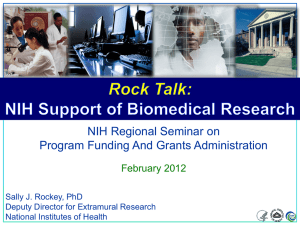
![Faculty Forward [PDF]](http://s2.studylib.net/store/data/005260716_1-e64c3a84465fecffce46203374b03bc3-300x300.png)
